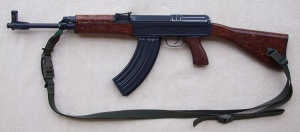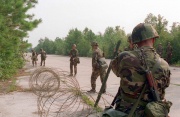Sa vz. 58
| |||||||||||||||||||||||||||||||||||||||||||||||||||||||||||||||
The Sa vz. 58 is a 7.62 mm assault rifle designed and manufactured in Czechoslovakia, accepted into service as the 7,62 mm samopal vzor 58 (“7.62 mm submachine gun model 1958”), replacing the 7.62 mm vz. 52 self-loading rifle and the 7.62 mm Sa 24 and Sa 26 submachine guns.
Contents |
[edit] Development
Development of the weapon began in 1956, and leading the project was chief engineer Jiří Čermák at the Konštrukta facility in Brno. The rifle was designed to use the Soviet intermediate 7.62x39mm M43 cartridge, rather than the Czech 7.62x45mm vz. 52 round, used in both the earlier vz. 52 rifle and the vz. 52 light machine gun. Over the period of 25 years (up until 1984) over 920,000 had been produced, used by the armed forces of the Czech and Slovak Republics, Cuba and several other Asian and African nations.
The vz. 58 was produced in three main variants: the vz. 58 P (Pěchotní - "infantry") – with a fixed buttstock, made of a synthetic material (wood impregnated plastic, older versions used a wooden stock), the vz. 58 V (Výsadkový - "airborne") – featuring a metal wire stock, folded to the right side, and the vz. 58 Pi (Pěchotní s infračerveným zaměřovačem - "infantry with infrared sight"), which is similar to the vz. 58 P but includes a receiver-mounted side rail (on the left side of the receiver housing) used to attach an NSP-2 night vision sight; it also has a detachable folding bipod and a conical flash suppressor.
[edit] Design details
The vz. 58 is a selective-fire gas-operated weapon that bleeds burnt propellant gases through a port in the barrel into a gas cylinder located above the barrel that contains a short-stroke piston. The locking system features a tilting locking piece hinged from the breech block that contains protrusions that descend into and engage notches in the receiver’s internal rails guiding the bolt carrier assembly. The weapon is unlocked when the bolt carrier begins moving rearward, propelled by the piston, forcing the breech locking device against an inclined surface on the bolt carrier which raises the locking piece upward and out of the locking recesses in the receiver. The spring extractor and firing pin are both housed inside the bolt assembly, while the fixed ejector is located at the base of the receiver. The weapon is striker-fired and the striker-hammer features its own operating spring.The rifle uses a trigger mechanism with a lever-type fire mode selector, which is also a manual safety against accidental firing. When the selector lever is placed in its rear position (“single fire”) the sear is disabled and the left striker catch is rotated by the disconnecter, which is depressed by the bolt carrier after every shot and is therefore disconnected from the striker catch. The forward setting of the selector lever (“automatic fire”) disables the disconnecter, and the left striker catch meshes with the sear mechanism. The center (“safe”) setting of the selector toggle mechanically blocks both the sear and disconnecter. The rifle also features an automatic internal safety, which prevents the weapon from discharging prematurely. The right striker-hammer catch disables the striker-hammer, and it can only be released by pulling the charging handle back and cocking the weapon.
The weapon is fed from a detachable curved magazine with a 30 cartridge capacity, made from a lightweight alloy. When the last cartridge from the magazine is fired, the bolt will remain locked open on the bolt catch, lifted by the magazine’s follower. The magazine release is located centrally at the bottom of the receiver housing, behind the magazine well. The bolt carrier features a guide rail for use with 10-round stripper clips (from the SKS carbine). Despite their similarity, Sa vz. 58 magazines are not interchangeable with those of the AK-47 and its derivatives.
The rifle’s iron sights consist of an adjustable front post and a sliding rear notched tangent with settings from 100 to 800 m, graduated every 100 m. The front sight base also serves as a mounting platform for the vz. 58 edged bayonet.
Additional equipment supplied with the rifle includes: 4 spare magazines, a speed-loading device, vz. 58 bayonet and scabbard, cleaning brush, muzzle cap, oil bottle, front sight adjustment tool and a threaded blank-firing adaptor.
[edit] Variants
- Vz. 58 P: Standard fixed stock.
- Vzor 58 V: Metal folding stock version for vehicle crew and airborne units.
- Vzor 58 Pi: Has a mounting for an infrared night vision NSP-2 sight, fixed stock, cone flash hider and folding bipod.
- Automatická puška ("automatic rifle") AP-Z 67: Experimental 7.62x51mm NATO caliber version developed in 1966.
- Útočná puška ("assault rifle") ÚP-Z 70: Experimental 5.56x45mm NATO version developed in 1970.
- Experimentální zbraň ("experimental weapon") EZ-B: Experimental bullpup prototype developed in 1976.
- Ruční kulomet ("light machine gun") codename KLEČ ("dwarf pine"): Experimental variant with a 590 mm barrel (similar to RPK), developed in 1976.
- Lehká odstřelovačská puška ("light sniper rifle") vz. 58/97: Experimental marksman rifle developed by VTÚVM Slavičín.
- Samopal ("submachine gun") vz. 58/98 "Bulldog": 9x19mm Parabellum variant developed by VTÚVM Slavičín.
- CZH 2003 Sport: Semi-automatic only variant for civilian consumption. Available with either a standard 390 mm or shortened 295 mm barrel.
- CZ 858 Tactical (in Canada VZ-58S): A semi-automatic variant designed for the civilian market in Canada. Available with standard or extended (482 mm) barrel lengths. External components have a new varnish coat (identical to the coating used on original military rifles).
- FSN01: Civilian semi-automatic variant. Available in standard or shortened (279 mm) barrel lengths, outer parts are blued.
[edit] Users
- Angola
- Cuba
- Czech Republic - Standard service rifle.[1]
- Czechoslovakia
- Cyprus
- Dominican Republic
- Ethiopia
- India
- Indonesia
- Iraq
- Lebanon[2]
- Libya
- Slovakia
- Sudan
[edit] Resources
| Gun Owners' Resource has the following relevant documents available for free download for the Sa vz. 58 and/or its variants: |
- Sa vz. 58 Sporter Rifle Instruction Manual (6.13MB file in .PDF file format, 43pgs.)
- INSTRUCTION MANUAL - CZ Mod. 58 (1.5M file in .PDF format, 31pgs.)

This article is either missing some diagrams which would help to illustrate a proper breakdown of the firearm in question or the diagrams which are here are inadequate. This article could use more input to fill in the missing bits. You (yes, you!) can help Gunsopedia provide more comprehensive information to our users by using your own knowledge to add to it.
The following diagrams are also available for reference:
[edit] Notes
- ↑ Czech army vz. 58 page.
- ↑ Lebanese Forces Weapons Page. Retrieved on July 28, 2007.




